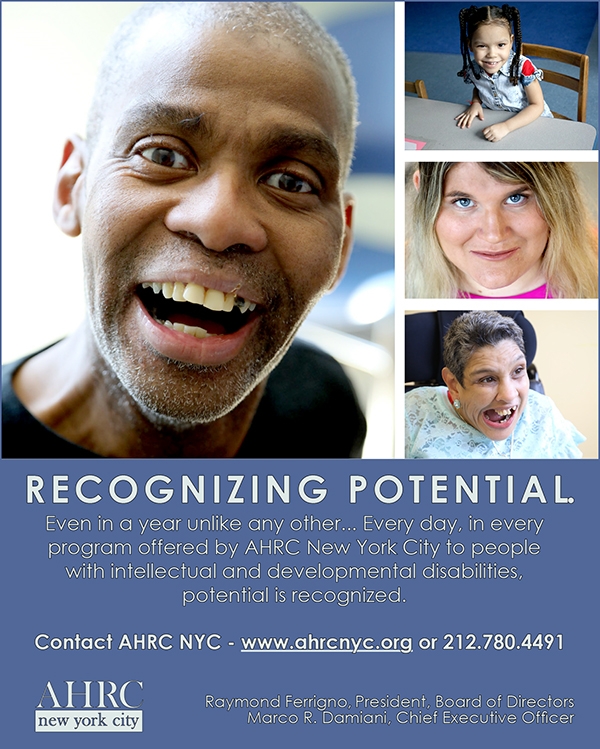The following is an interview with Laura McCabe, BCBA, Coordinator at AHRC New York City’s Middle High School.
What made you decide to go into this field? Did you always know you wanted to work with students on the autism spectrum?
I was always interested in understanding the human mind and behavior. The field of psychology seemed like a good start for learning about this topic. During my undergraduate studies, I developed an interest in working with school-age children. I did not enjoy speaking in front of larger groups of people, so teaching was not a career option for me. Graduate school in the field of school psychology was a better fit for my interest in learning how to help students use their strengths to compensate for weaknesses. During the time I was practicing as a school psychologist, I discovered the need to further study the science of applied behavior analysis which resulted in working with people with different developmental disabilities, primarily autism.

Laura McCabe, BCBA
I believe that in our profession, you never stop learning, not only because of the rapid advancement in the field of behavioral science, but also due to the uniqueness in the functioning of each individual with an autism diagnosis. There are no two students alike and although we follow the same principles of behavior, you have to treat each student as a blank canvas. Every student has a specific genetic background and environmental variables that require us to create individualized interventions. So, you never stop learning as you work with one student at a time.
Collaboration with other professionals in the field and the caregivers is essential. I will never be successful in my profession without the continuous support of administrators, teachers, and assistants. It is also reassuring to know that when I run into a difficult situation, I have a great supervisor who will always counsel and guide me.
What do behavior challenges look like in the classroom? How do you prepare the staff before the school year?
Most challenging behaviors can be addressed through instruction differentiation and using a multisensory approach in teaching to compensate for deficits in verbal and non-verbal abilities, social and emotional regulation. Students may have difficulties related to attending and remaining focused during instruction, which we address using visual and individualized schedules of reinforcement. We teach students appropriate replacement behaviors by identifying the function [editorial note: the word function here speaks to why the person is exhibiting the behavior] of the challenging behaviors.
We train teachers in utilizing applied behavior methodology in modifying instruction and developing classroom environmental supports conducive to learning. I train teachers in implementing our research-based ABA curriculum and making data-based decisions when developing goals for instruction. When working as a team to develop instructional and behavioral interventions, we discuss the students’ strengths and weaknesses, as well as the behaviors we need to address.
It is important to keep a balance between the need to discuss students’ performance and their behavior challenges with the instructional team members involved in the educational process, while maintaining student dignity and confidentiality.
- Do not describe a student through the prism of their challenging behaviors or their developmental disability (i.e., non-verbal, risk of elopement, aggressive). Just because they displayed these behaviors in the past, do not expect them to do it again.
- Students should get a new chance to change their behavior repertoire as they work with different people in different settings. Get to know each student without factoring past behavior struggles and believe in their ability to acquire desired replacement skills. When you keep an open mind, you give students a chance to change.
How do you initially evaluate a student with challenging behaviors?
I conduct direct and indirect assessments to identify the function of the challenging behaviors. Teachers, clinicians, administrators, and family members can express concerns regarding challenging behavior. Along with the school psychologist, I observe the student in the classroom and take data on the duration, frequency, and intensity of the challenging behaviors. I conduct interviews, questionnaires, and surveys with teachers, assistants, and family members.
If the function is evident using these methods, I develop a hypothesis regarding the behavior function and create interventions with a system of data collection. Sometimes the function of challenging behavior cannot be easily determined using only direct and indirect observations. A functional analysis needs to be conducted to determine the function of maintaining the behavior. If a functional assessment is similar to detective work, functional analysis is similar to a controlled experiment in which different variables are manipulated to determine why the target behavior occurs and to develop specific interventions to teach new skills and shape desired replacement behaviors.
The most recent functional analysis I conducted was for a student who displayed loud vocalizations of great intensity and duration, loud enough to be heard in the adjacent classrooms and offices with an average duration of a few hours a day. A behavior protocol was created based on a hypothesized function that escapes from task demand and attention-seeking may be maintaining this behavior.
Specific interventions to address these functions were not successful in reducing the challenging behaviors. When a functional analysis was conducted, it was indicative that the primary function of loud vocalizations was automatic (self-stimulatory). A Behavior Support Plan was created with interventions specific to address this function, successfully reducing the intensity and duration of the loud vocalizations.
In addition to the data used for behavioral interventions, data is collected to determine skill acquisition and maintenance for curriculum instruction. We continuously search for modalities to individualize instruction and to find the best instructional strategies that allow students to learn academic content as well as to develop daily living skills.
How do you know which intervention or tool to use when a student displays outbursts and other behaviors in the classroom?
I start by identifying the main function of the challenging behavior. The most common possible functions are to:
- Get someone’s attention
- Escape or avoid a task/demand
- Get access to a desired item, person, or activity
- Engage in self-stimulatory behavior.
Interventions are created for each specific function. In the school setting, we use a positive behavior approach. A lot of emphasis is placed on proactive and preventive strategies. I use the principles of reinforcement to develop schedules of reinforcement and design contingencies for students’ behavior that will motivate them to acquire new skills and develop behaviors conducive to learning in the classroom.
In our field, we know that each student has a unique pattern of behavior that requires the instructors to keep an open mind and to identify the students’ strengths to compensate for existing weaknesses. It takes planning, constant problem solving to differentiate instruction and modify behavior plans to make them work for each student.
The primary goal of behavior interventions is to address behavior barriers to facilitate learning. When instruction is individualized by taking into account student learning style, and when teachers are using research-based instructional strategies, behavior challenges are greatly reduced.
Examples of strategies that use applied behavior analysis methodology are:
- Task analysis (breaking a complex task into smaller steps that can be taught one at a time)
- Incidental teaching (using the environment to facilitate students’ responses reinforced by intrinsic motivation)
- Discrete trial training (teaching specific targets through repetition and consistent use of same instruction paired with reinforcing each student’s independent response
- Natural environmental teaching (using small group instruction and modifying the curriculum and assessments to use students’ strengths to address weaknesses).
How do you communicate with the families about this?
After we develop a Behavior Support Plan we send a copy of the plan home and meet with the family members to discuss the interventions and answer any questions regarding the plan implementation. Parents can inquire about the progress regarding the implementation of the intervention at any time. We also immediately inform them when changes to the plan are made based on the data collection.
What role do parents and other family members play in supporting a child on the spectrum who has challenging behaviors?
Parents play the biggest part in any intervention for skill generalization and maintenance. Everything the student learns in school should have an application in everyday life; otherwise, it is no more than a mental exercise in memorization. An unused academic concept or behavior skill will be forgotten. Communication with families and other instructors becomes paramount in transferring the skills acquisition from one setting to another and for creating a foundation for instructional scaffolding.
Can you describe one of the most rewarding experiences you’ve had working with a student at AHRC NYC’s Middle/High School or Blue Feather?
The most rewarding moment is when students are acquiring academic and functional skills due to consistently and accurately implementation of ABA instruction in the classroom accomplished through good programming and training received during professional development. What gives me the most satisfaction and motivates me to continue to do my job every day is when students are moving toward becoming adults, capable of functioning with different degrees of support as productive members of society.
What advice do you have for families of children with autism who display challenging behaviors?
My advice to families is to try to understand what their child is trying to communicate or obtain from engaging in challenging behaviors and teach him/her how to get what they want and need by displaying the desired behavior. Being consistent and predictable in their expectations and interactions with their children, creating systems of reinforcement contingent on the child displaying desired behavior, and creating daily routines to teach and maintain new skills will decrease challenging behaviors.
And guidance for teachers who struggle with this issue in their classrooms?
Believe in your students’ ability to learn, set clear expectations in the classroom, and reinforce any occurrence of desired behaviors. Celebrate success, forget about student struggles. Students are mirroring your emotions. If you are positive and enthusiastic, they will feel at ease and probably more willing to follow your directions. Setting clear instructional goals and a system of data tracking will allow teachers to stay focused on what matters and report student’s progress to all members of the instructional team, including the caregivers.
Laura McCabe, BCBA, studied psychology in Romania and the United States. She earned her Master of Arts in school psychology at Adelphi University, while completing the course work in Applied Behavior Analysis at Stony Brook University. She conducted her internship for BCBA accreditation at the Cody Center, part of the Stony Brook University Medical Center, where she worked with children aged 6-16. She earned her bachelor’s from SUNY College of Old Westbury. She also has worked at AHRC New York City’s Brooklyn Blue Feather Elementary School.





